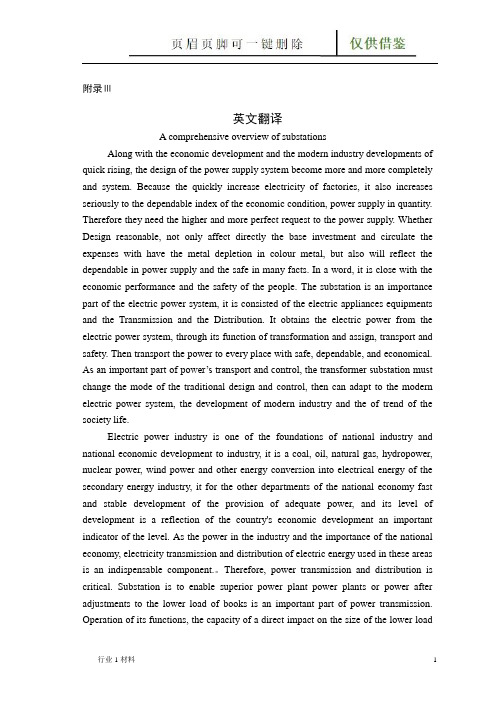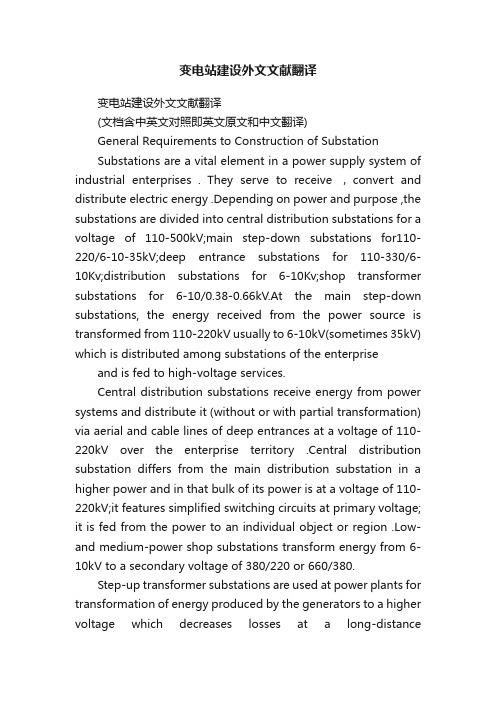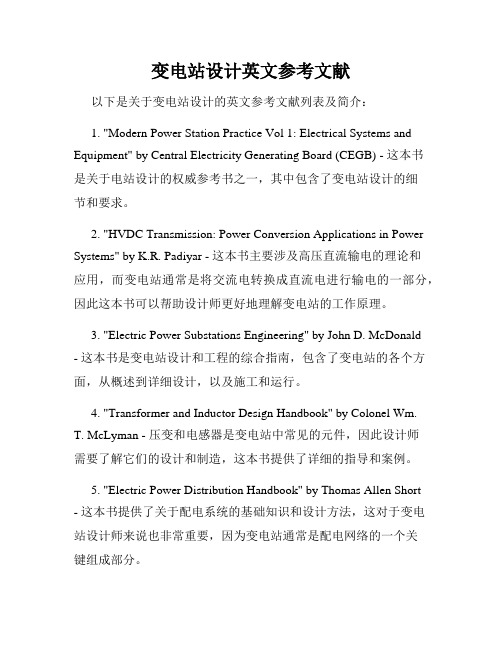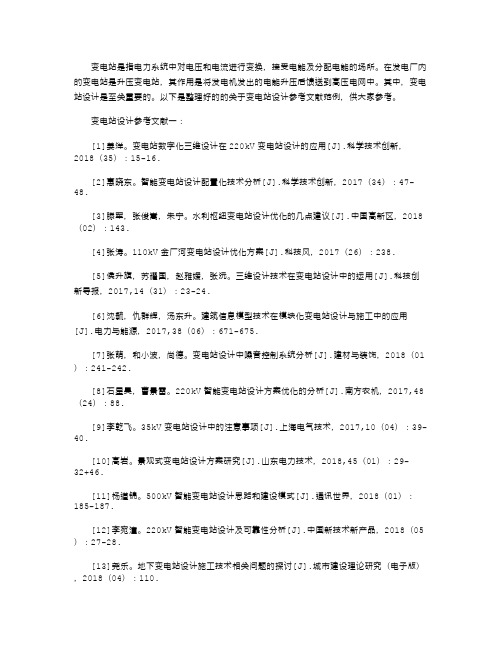数字化变电站研究-参考文献及英文文献
变电站外文翻译外文文献英文文献变电站的综合概述(工程科技)

附录Ⅲ英文翻译A comprehensive overview of substationsAlong with the economic development and the modern industry developments of quick rising, the design of the power supply system become more and more completely and system. Because the quickly increase electricity of factories, it also increases seriously to the dependable index of the economic condition, power supply in quantity. Therefore they need the higher and more perfect request to the power supply. Whether Design reasonable, not only affect directly the base investment and circulate the expenses with have the metal depletion in colour metal, but also will reflect the dependable in power supply and the safe in many facts. In a word, it is close with the economic performance and the safety of the people. The substation is an importance part of the electric power system, it is consisted of the electric appliances equipments and the Transmission and the Distribution. It obtains the electric power from the electric power system, through its function of transformation and assign, transport and safety. Then transport the power to every place with safe, dependable, and economical. As an important part of power’s transport and control, the transformer substation must change the mode of the traditional design and control, then can adapt to the modern electric power system, the development of modern industry and the of trend of the society life.Electric power industry is one of the foundations of national industry and national economic development to industry, it is a coal, oil, natural gas, hydropower, nuclear power, wind power and other energy conversion into electrical energy of the secondary energy industry, it for the other departments of the national economy fast and stable development of the provision of adequate power, and its level of development is a reflection of the country's economic development an important indicator of the level. As the power in the industry and the importance of the national economy, electricity transmission and distribution of electric energy used in these areas is an indispensable component.。
变电站建设外文文献翻译

变电站建设外文文献翻译变电站建设外文文献翻译(文档含中英文对照即英文原文和中文翻译)General Requirements to Construction of SubstationSubstations are a vital element in a power supply system of industrial enterprises.They serve to receive ,convert and distribute electric energy .Depending on power and purpose ,the substations are divided into central distribution substations for a voltage of 110-500kV;main step-down substations for110-220/6-10-35kV;deep entrance substations for 110-330/6-10Kv;distribution substations for 6-10Kv;shop transformer substations for 6-10/0.38-0.66kV.At the main step-down substations, the energy received from the power source is transformed from 110-220kV usually to 6-10kV(sometimes 35kV) which is distributed among substations of the enterprise and is fed to high-voltage services.Central distribution substations receive energy from power systems and distribute it (without or with partial transformation) via aerial and cable lines of deep entrances at a voltage of 110-220kV over the enterprise territory .Central distribution substation differs from the main distribution substation in a higher power and in that bulk of its power is at a voltage of 110-220kV;it features simplified switching circuits at primary voltage; it is fed from the power to an individual object or region .Low-and medium-power shop substations transform energy from 6-10kV to a secondary voltage of 380/220 or 660/380.Step-up transformer substations are used at power plants for transformation of energy produced by the generators to a higher voltage which decreases losses at a long-distancetransmission .Converter substations are intended to convert AC to DC (sometimes vice versa) and to convert energy of one frequency to another .Converter substations with semiconductor rectifiers are convert energy of one frequency to another .Converter substations with semiconductor rectifiers are most economic. Distribution substations for 6-10kV are fed primarily from main distribution substations (sometimes from central distribution substations).With a system of dividing substations for 110-220kV, the functions of a switch-gear are accomplished by switch-gears for 6-10kV at deep entrance substations.Depending on location of substations their switch-gear may be outdoor or indoor. The feed and output lines at 6-10kV substations are mainly of the cable type .at 35-220kV substations of the aerial type .When erecting and wiring thesubstations ,major attention is given to reliable and economic power supply of a given production.Substations are erected by industrial methods with the use of large blocks and assemblies prepared at the site shops of electric engineering organizations and factories of electrical engineering industry .Substations are usually designed for operation without continuous attendance of the duty personnel but with the use of elementary automatic and signaling devices.When constructing the structural part of a substation .it is advisable to use light-weight industrial structures and elements (panels ,floors ,etc.) made of bent sections .These elements are pre-made outside the erection zone and are only assembled at site .This considerably cuts the terms and cost of construction.Basic circuitry concepts of substations are chosen when designing a powersupply system of the enterprise .Substationsfeature primary voltage entrances .transformers and output cable lines or current conductors of secondary voltage .Substations are mounted from equipment and elements described below .The number of possible combinations of equipment and elements is very great .Whenelaborating a substation circuitry ,it is necessary to strive for maximum simplification and minimizing the number of switching devices .Such substations are more reliable and economic .Circuitry is simplified by using automatic reclosure or automatic change over to reserve facility which allows rapid and faultless redundancy of individual elements and using equipment.When designing transformer substations of industrial enterprises for all voltages ,the following basic considerations are taken into account:1. Preferable employment of a single-bus system with using two-bus systems only to ensure a reliable and economic power supply;2. Wide use of unitized constructions and busless substations;3.Substantiated employment of automatics and telemetry ;if the substation design does not envisage the use of automatics or telemetry ,the circuitry is so arranged as to allow for adding such equipment in future without excessive investments and re-work./doc/554c0a220622192e453610661ed9ad5 1f01d5431.html e of simple and cheap devices-isolating switches ,short-circuiting switches ,load-breaking isolators ,fuses ,with due regard for their switching capacity may drastically cut the need for expensive and critical oil ,vacuum ,solenoid and air switches .Substation and switch-gear circuitries are so made that using the equipment of eachproduction line is fed from individual transformers ,assemblies ,the lines to allow their disconnection simultaneously with mechanisms without disrupting operation of adjacent production flows.When elaborating circuitry of a substation, the most vital task is to properly choose and arrange switching devices(switches ,isolators ,current limiters ,arresters ,high-voltage fuses).The decision depends on the purpose ,power and significance of the substation.Many years ago, scientists had very vague ideas about electricity. Many of them thought of it as a sort of fluid that flowed through wires as water flows through pipes, but they could not understand what made it flow. Many of them felt that electricity was made up of tiny particles of some kind ,but trying to separate electricity intoindividual particles baffled them.Then, the great American scientist Millikan, in 1909,astounded the scientific world by actually weighing a single particle of electricity and calculating its electric charge. This was probably one of the most delicate weighing jobs ever done by man,for a single electric particle weighs only about half of a millionth of a pound. To make up a pound it would take more of those particles than there are drops of water in the Atlantic Ocean.They are no strangers to us, these electric particles, for we know them as electrons. When large numbers of electrons break away from their atoms and move through a wire,we describe this action by saying that electricity is flowing through the wire.Yes,the electrical fluid that early scientists talked about is nothing more than electrical flowing along a wire.But how can individual electrons be made to break awayfrom atoms? And how can these free electrons be made to along a wire? The answer to the first question lies in the structure of the atoms themselves. Some atoms are so constructed that they lose electrons easily. An atom of copper, for example ,is continually losing an electron, regaining it(or another electron),and losing it again. A copper atom normally has 29 electrons, arranged in four different orbits about its nucleus. The inside orbit has 2 electrons. The next larger orbit has 8.The third orbit is packed with 18 electrons . And the outside orbit has only one electron.It is this outside electron that the copper atom is continually losing, for it is not very closely tied to the atom. It wanders off, is replaced by another free-roving electron, and then this second electron also wandersaway.Consequently,in a copper wire free electrons are floating around in all directions among the copper atoms.Thus, even through the copper wire looks quite motionless to your ordinary eye, there is a great deal of activity going on inside it. If the wire were carrying electricity to an electric light or to some other electrical device, the electrons would not be moving around at random. Instead, many of them would be rushing in the same direction-from one end of the wire to the other.This brings us to the second question .How can free electrons be made to move along a wire? Well ,men have found several ways to do that .One way is chemical. V olta,s voltaic pile,or battery, is a chemical device that makes electricity(or electrons)flow in wires. Another way is magnetic. Faraday and Henry discovered how magnets could be used to make electricity flow in a wire.MagnetsAlmost everyone has seen horseshoe magnets-so called because they are shaped like horseshoes. Probably you have experimented with a magnet, and noticed how it will pick up tacks and nails, or other small iron objects. Men have known about magnets for thousands of years.Several thousand years ago, according to legend, a shepherd named Magnes lived on the island of Crete, in the Mediterranean Sea .He had a shepherds crook tipped with iron. One day he found an oddly shaped black stone that stuck to this iron /doc/554c0a220622192e453610661ed9ad51f0 1d5431.html ter, when many other such stones were found, they were called magnets(after Magnets).These were natural magnets.In recent times men have learned how to make magnets out of iron. More important still, they have discovered how to use magnets to push electrons through wires-that is, how to make electricity flow. Before we discuss this, there arecertain characteristics of magnets that we should know about.If a piece of glass is laid on top of a horse- shoes magnet, and if iron filings are then sprink ledon the glass, the filings will arrange themselves into lines. If this same thing is trid with a bar magnet(a horseshoe magnet straightened out),the lines can be seen more easily. These experiments demonstrate what scientists call magnetic lines of force. Magnets, they explain, work through lines of force that ext- end between the two ends of the magnet. But electrons seem to have magnetic lines of force around them, too.This can be proved by sticking a wire through a piece ofcard board, sprinkling iron filings on the cardboard, and connecting a battery to the wire. The filings will tend to form rings around the wire,as a result of the magnetism of the moving electrons(or electricity).So we can see that there is arelationship betweenmoving electrons and magnetism, Magnetism results from the movement of electrons.Of course, electrons are not really flowing in the bar magnet, but they are in motion, circling the nuclei of the iron atoms. However, in the magnet, circling thelined up in such a way that their electrons are circling in the same direction. Perhaps a good comparison might be a great number of boys whirling balls onstrings in a clockwise direction around their heads.翻译:变电站建设的一般要求变电站(所)在电源系统的工业企业是一个至关重要的因素。
数字化变电站测控系统的研究与实现

数字化变电站测控系统的研究与实现【摘要】研究IEC61850标准,建设数字化变电站。
从变电站的构成,智能化电网的建设及变电站的分层定位,操作画面的功能,同期断路器的操作进行设计与实施。
在系统中的智能电子设备(IED)采用了Sepam1000+系列微机保护测控装置和监控仪表PM500使系统智能化更高,用高速以太网组成的通讯网使系统可靠、安全。
经过一年多的运行证明,变电站运行效率高,操作更为方便,提高了变电站自动化的程度。
【关键词】IEC61850标准;数字化变电站;智能电网;测控系统;以太网1.引言数字化的变电站研究与建设,应按IEC TC57技术委员会出台的IEC 61850标准进行研究与建设。
其目的将变电站按统一的标准,同一操作使各厂家之间的设备互相通信和互相操作。
按统一的标准建设数字化变电站,可以优化电网运行方式对提高设备的可靠性,保障电网安全、稳定运行,实现减员增效具有重要的社会效益和经济效益。
我国在2008年开始执行以IEC 61850标准为蓝本的数字化变电站DL/T860系列标准。
2.数字化变电站功能数字化变电站在自动化系统的结构[1]上可分为:一次设备智能化、二次设备网络化。
在逻辑结构上可分为三个层次,根据IEC 61850标准这三个层次为“站控层”、“间隔层”、“过程层”。
2.1 数字化变电站功能数字化变电站以数字信息传送为对象,对数字化信息进行统一建模,用标准的网络信息构成变电站监控系统,如图1所示;2.2 站控层主要功能(1)将站内的两级高速网络的信息汇总的实时数据,信息不断更新实时数据库,按时登录历史数据库。
(2)将站内的有关数据、信息报送控制中心,同时将中心的有关指令下达到“间隔层”、“过程层”,进行执行。
(3)具有在线编成全站的操作控制功能,和在线对“间隔层”、“过程层”的维护,在线修改参数等。
(4)具有站内的监控、报警,变电站故障自动分析,操作学习的功能。
2.3 间隔层功能(1)承上启下的通信功能,完成“过程层”及“站控层”网络通信功能。
变电站设计英文参考文献

变电站设计英文参考文献以下是关于变电站设计的英文参考文献列表及简介:1. "Modern Power Station Practice Vol 1: Electrical Systems and Equipment" by Central Electricity Generating Board (CEGB) - 这本书是关于电站设计的权威参考书之一,其中包含了变电站设计的细节和要求。
2. "HVDC Transmission: Power Conversion Applications in Power Systems" by K.R. Padiyar - 这本书主要涉及高压直流输电的理论和应用,而变电站通常是将交流电转换成直流电进行输电的一部分,因此这本书可以帮助设计师更好地理解变电站的工作原理。
3. "Electric Power Substations Engineering" by John D. McDonald- 这本书是变电站设计和工程的综合指南,包含了变电站的各个方面,从概述到详细设计,以及施工和运行。
4. "Transformer and Inductor Design Handbook" by Colonel Wm. T. McLyman - 压变和电感器是变电站中常见的元件,因此设计师需要了解它们的设计和制造,这本书提供了详细的指导和案例。
5. "Electric Power Distribution Handbook" by Thomas Allen Short- 这本书提供了关于配电系统的基础知识和设计方法,这对于变电站设计师来说也非常重要,因为变电站通常是配电网络的一个关键组成部分。
6. "Switchgear and Protection" by J.B Gupta - 变电站中使用的开关设备和保护系统非常关键,这本书提供了涵盖相关主题的详细信息,包括故障和过电压保护,以及开关设备的选择和维护。
数字化变电站发展研究-中电联

3
当前数字化变电站技术仍存在一些技术和管理方 面的挑战,需要进一步研究和改进。
研究不足与展望
当前研究对数字化变电站技术的经济性分析不够深入,未 来需要进一步探讨数字化变电站技术的经济效益和社会效 益。
针对数字化变电站技术的标准体系和规范制定仍需进一步 完善,以促进技术的推广应用和行业健康发展。
未来数字化变电站技术将进一步融合人工智能、大数据等 先进技术,实现更加智能化、自动化的电网运行和管理, 为能源互联网的发展提供有力支撑。
加强国际合作与交流
中电联将继续加强与国际同行的合作与交流,共同推动数字化变电 站技术的发展和应用。
06
CHAPTER
数字化变电站发展面临的挑 战与对策
技术挑战与对策
技术挑战
随着数字化变电站技术的不断发展,技术更新换代速度加快 ,对设备兼容性和技术人员的技能提出了更高的要求。
对策
加强技术研发和人才培养,提高设备兼容性和技术人员的技 能水平,同时建立完善的技术支持体系,确保数字化变电站 的稳定运行。
传统变电站的局限性
传统变电站存在设备繁多、信息孤岛、维护困难等问题,难以满足 现代电力系统的发展需求。
数字化技术的进步
随着数字化技术的不断发展,数字化变电站成为解决上述问题的有 效途径,具有广阔的应用前景。
研究目的和意义
研究目的
本研究旨在深入探讨数字化变电站的 发展现状、技术特点、应用优势及存 在的问题,为数字化变电站的推广和 应用提供理论支持和实践指导。
对策
加强与政府部门的沟通与协调,了解和掌握相关政策法规,确保数字化变电站的 建设和运行符合法律法规要求。同时加强企业自身的环保和安全管理,提高企业 的社会责任感。
07
变电站设计参考文献(精选95个)

变电站是指电力系统中对电压和电流进行变换,接受电能及分配电能的场所。
在发电厂内的变电站是升压变电站,其作用是将发电机发出的电能升压后馈送到高压电网中。
其中,变电站设计是至关重要的。
以下是整理好的的关于变电站设计参考文献范例,供大家参考。
变电站设计参考文献一: [1]姜洋。
变电站数字化三维设计在220kV变电站设计的应用[J].科学技术创新,2018(35):15-16. [2]惠晓东。
智能变电站设计配置化技术分析[J].科学技术创新,2017(34):47-48. [3]滕军,张俊嵩,朱宁。
水利枢纽变电站设计优化的几点建议[J].中国高新区,2018(02):143. [4]张涛。
110kV金厂河变电站设计优化方案[J].科技风,2017(26):238. [5]侯升旗,苏耀国,赵雅媛,张沅。
三维设计技术在变电站设计中的运用[J].科技创新导报,2017,14(31):23-24. [6]沈毓,仇群辉,汤东升。
建筑信息模型技术在模块化变电站设计与施工中的应用[J].电力与能源,2017,38(06):671-675. [7]张萌,和小波,尚德。
变电站设计中噪音控制系统分析[J].建材与装饰,2018(01):241-242. [8]石星昊,曹景雷。
220kV智能变电站设计方案优化的分析[J].南方农机,2017,48(24):88. [9]李乾飞。
35kV变电站设计中的注意事项[J].上海电气技术,2017,10(04):39-40. [10]高岩。
景观式变电站设计方案研究[J].山东电力技术,2018,45(01):29-32+46. [11]杨道锦。
500kV智能变电站设计思路和建设模式[J].通讯世界,2018(01):185-187. [12]李宛潼。
220kV智能变电站设计及可靠性分析[J].中国新技术新产品,2018(05):27-28. [13]尧乐。
地下变电站设计施工技术相关问题的探讨[J].城市建设理论研究(电子版),2018(04):110. [14]宋祉明,张伟,徐肃,张轶,李智玲,付小平。
基于IEC61850数字化变电站的研究

基于IEC61850数字化变电站的研究摘要变电站自动化技术的发展和微机保护的广泛应用极大地提高了电网的自动化水平和管理水平,但是由于变电站自动化系统和保护设备的通信协议不统一,造成系统无缝集成困难,生命周期缩短;设备之间互操作性差,维护工作量大,改造升级困难。
同时变电站的一、二次设备的控制信号发送、模拟量采集靠大量的电缆连接实现,不仅浪费了大量的财力,而且抗干扰性大大降低。
随着IEC61850 标准的发布,电子式互感器、智能化高压电气设备的发展,电气设备在线状态检测、变电站运行操作培训仿真等技术日趋成熟,以及计算机网络技术的高速发展,使得建设数字化变电站具备了必要的技术条件。
本文在研究数字化变电站相关理论和技术的基础上,总结变电站数字化技术的现状、发展趋势,初步形成数字化变电站的整体模型,提出了数字化变电站的特征和需要实现的功能。
研究数字化变电站三层网络结构下通信的实现,运用前面的研究成果,探讨在现有技数条件下建设数字化变电站,如何实现与以往设备的兼容,使本文提出的数字化变电站改造方案更具有实用性和可操作性。
关键词:数字化变电站,IEC61850 标准,电子式互感器,智能化高压电气设备DIGITAL SUBSTATION BASED ON IEC61850 RESEARCHABSTRACTWith the development of integrated substation automation technology and microprocessor-based protections,electrical power system automation is highly promoted. But the communication protocols among IEDs produced by different manufacturers are different,the SA system will not be integrated well.Also,IEDs from different manufacturers are difficult to achieve interoperability.Maintenance and upgrading such a SA system may cost much resource and time.In a substation,many cables made with copper are used to transmit control signal and analog data,so highly lower the anti-interference of a SA system. The IEC6185O standard electronic measurement transformers,intelligent control of high voltage electrical apparatus,computer network technology,etc,all these make it possible to build a digital substation. So,the thesis will study these key technologies and intelligence devices,and give a reference design project of digital substations. First,a digital substation model and main charaeters are formed in this thesis. Then a communication network construction principle of digital substations,including proeess buses and Station buses,are developed. According with the Principle,with the reaserch on the key technologies of 110kV wucun digital substation in Shenzhen Power Supply Bureau and 220kV sanxiang digital substation in nanfang Power Supply Bureau,this article analysis a digital substation’ s layered communication network framework. Deeply. Based on the investigation of intelligence devices of digital substations,selcetion and configuration principle of devices is summarized.KEY WORDS: digital subatation,IEC61850 standard ,electronictransformer ,intelligent control of high voltage electrical apparatus目录摘要 (I)ABSTRACT........................................................... I I 第1章绪论. (1)第2章数字化变电站系统的发展及现状 (3)2.1 变电站自动化系统的发展 (3)2.2 变电站自动化系统通信规约现状 (6)2.3 小结 (9)第3章数字化变电站的技术优势及经济效益 (10)3.1 数字化变电站的技术优势 (10)3.2 经济效益 (13)3.3 小结 (14)第4章 IEC61850 标准介绍 (15)4.1 IEC61850 标准主要内容 (15)4.1.1 IEC61850 标准内容 (15)4.2.1 分层 (17)4.2.2变电站通信网络的实时性以及时延不确定性研究 (18)4.3 本章小结 (35)总结与展望 (36)1.全文工作总结 (36)2. 工作展望 (37)致谢 (38)参考文献 (39)附录1 (43)第1章绪论变电站自动化系统是在计算机技术和网络通信技术基础上发展起来的。
基于IEC61850的数字化变电站智能模型研究

基于IEC61850的数字化变电站智能模型研究摘要基于IEC61850标准的数字化变电站综合自动化系统,采用了GOOSE跳闸服务技术和现地智能服务终端等先进技术手段,引起了变电站自动化系统在测控、保护、故障录波等功能实现方面的巨大变革。
在分析了基于IEC618550标准数字化变电站逻辑组成结构后,以变压器保护功能的实现为例对数字化变电站智能模型进行了详细分析研究。
最后讨论了数字化变电站自动化系统中的GOOSE智能服务模型。
关键词IEC61850;数字化变电站;GOOSE随着结构复杂、大参数、高电压等级复杂智能电网建设步伐的不断加快,区域大电网对变电站远程集中调度自动化基础系统运行可靠新、精确性、以及智能自动化水平等均提出了更高的要求。
目前我国变电站自动化系统中广泛使用IEC60870系列的变电站通信规约标准,但是由于IEC60870标准中还有许多需要完善的地方,在实际使用过程中还存在很大不足,不能很好解决好变电站自动化系统中各智能服务IED电子设备间的互操作性和开放兼容性,已成为了变电站自动化系统发展的重要瓶颈。
IEC61850是国际电工组织颁布的系统统一的变电站自动化系统标准,为变电站自动化提供了统一的标准,实现了变电站自动化系统中不同智能IED电子设备间的数据信息共享、互操作、以及即插即用的等功能,解决了变电站自动化系统升级和扩容等改造过程中大量自动化设备接入通信转换问题。
1 智能数字化变电站结构体系常规变电站的保护、测控、以及其他装置等与感应式电压(电流)互感器、电气一次设备间的联接主要通过控制或信号二次电缆。
由于整个变电站自动化系统调度运行过程中所需的数据、信号、命令等信息十分繁多,采用二次电缆连接方式大大增大了变电站自动化系统的接线复杂性。
智能数字化变电站自动化系统采用智能化一次设备(电子式互感器、智能化终端开关控制设备等)和网络化的二次系统设备分层(将变电站系统划分为过程层、间隔层、和站层三层结构),从而实现了变电站自动化系统系统化、集成化、网络化等功能特性,大大优化了变电站逻辑接线结构。
- 1、下载文档前请自行甄别文档内容的完整性,平台不提供额外的编辑、内容补充、找答案等附加服务。
- 2、"仅部分预览"的文档,不可在线预览部分如存在完整性等问题,可反馈申请退款(可完整预览的文档不适用该条件!)。
- 3、如文档侵犯您的权益,请联系客服反馈,我们会尽快为您处理(人工客服工作时间:9:00-18:30)。
参考文献[1]张沛超,高翔.数字化变电站系统结构【J】.电网技术.2006年12月,第30卷第24期.[2]高翔,张沛超.数字化变电站的主要特征和关键技术【J】.电网技术.2006年12月,第30卷第23期.[3]沈键,黄晓峰,高贵旺,徐石明,丁杰,黄国方.数字化变电站的关键技术【J】.江苏电机工程.2007年8月,第26卷增刊.[4]丁杰.数字化变电站技术特征和架构研究【J】.江苏电机工程.2007年8月,第26卷增卷.[5]赵卫霞.关于数字化变电所的思考【J】.云南电力技术.2008年6月,第36卷.[6]高翔.数字化变电站应用技术【M】.北京:中国电力出版社,2008.[7]黄益庄.变电站综合自动化技术【M】.北京:中国电力出版社,2000.[8]葛荣良.数字化变电站技术综述【C】.华东电力试验研究院有限公司.[9]【德】Klaus-Peter Brand,【德】Volker Lohmann,【德】Wolfgang Wimmer.变电站自动化【M】.北京:中国电力出版社,2009.[10]吴皓.数字化变电站设计简述【J】.企业科技与发展.2009年第14期.[11]隆丽,王国海.浅谈数字化变电站的基础技术【J】.输变电技术,2007年云南电力技术论坛论文集.[12]施卫华,徐俊.数字化变电站技术发展的探讨【J】.昆明冶金高等专科学校自动化与电力学院,赛尔输配电产品应用开关卷总第84期.[13]张顺.变电站自动化系统的现状及发展【J】.科技情报开发与经济.2003年,第9期第13卷.[14]袁敬中.数字化变电站自动化系统【J】.华北电力技术.2006年第10期.[15]陈雪莹.数字化变电站方案探讨【J】.能源与环境.2010年第3期.[16]于京燕,乔国帅,刘腾.数字化变电站综合自动化系统的问题分析及处理建议【J】.河北电力技术.2010年2月,第29卷第1期.[17]吴琴芳,陈恳.IEC61850与数字化变电站的应用研究【J】.电气技术.2009年2期.[18]王惠文.基于61850的数字化变电站设计方案探讨【J】.宁夏电力.2009年第1期.[19]刘从洪.基于IEC61850的数字化变电站通信研究.硕士学位论文.成都:西南交通大学,2008.[20]易永辉,曹一家,张金江,刘波,徐立中,郭创新.基于IEC61850标准的新型集中式IED【J】.电力系统自动化.2008年6月25日,第32卷第12期.[21]耿江海,高树国,刘海峰,杜大全.数字化变电站IED通信网络的建立【J】.科技信息.2008年第20期.[22]戴晓辉.数字化变电站网络通信技术【J】.科技信息.2010年第35期.[23]张慧哲.电子式电流互感器的数字通讯方案的研究.硕士学位论文.秦皇岛:燕山大学,2005.[24]陈韦.关于数字化变电站自动化技术应用【J】.科学之友.2010年02月(06).[25]田林云.浅述数字化变电站是未来变电站发展的趋势【J】.科学之友.2010年01月(02).[26]宋文凯,岑凯辛.数字化变电站在我国的新发展【J】.电气时空,2010年6月.[27]夏永军,苏昊,胡刚,董永德.数字化变电站研究现状与应用展望【J】.湖北电力.2006年7月,第31卷第3期.[28]汪熙珍.二次架构设计【J】.四川电力技术.2009年6月,第32卷第3期.[29]刘彦红.数字化变电站二次系统方式实现关键技术分析【J】.科技资讯.2010年第7期.[30]黄学卫,董玉玲,董丽丽.数字化变电站中的非常规互感器【J】.电力系统保护与控制.2009年4月16日,第37卷第8期.[31]黄颖.数字化变电站二次智能装置的研究.硕士学位论文.上海:上海交通大学,2006.[32]刘孝先,曾清,邹晓莉,黄蕙,刘辉.电子式互感器的应用【J】.电力系统及其自动化学报.2010年2月,第22卷第1期.[33]侯晓凤.电子式电流互感器在数字化变电站中的应用刍议【J】.科协论坛.2010年11月下期.[34]徐大可,赵建宁,张爱祥,鉴庆之,黄德祥,孙志杰.电子式互感器在数字化变电站中的应用【J】.高电压技术.2007年1月,第33卷第1期.第1页共6页[35]张劲松,俞建育.电子式电压互感器在数字化变电站中的应用【J】.华东电力.2009年8月,第37卷第8期.[36]马飞.数字化变电站设备监测系统【J】.智能电网.2009年12月.[37]冯孝宏.数字化变电站在线监测技术【J】.2008中国电力系统保护与控制学术研讨会文集.[38]陈斌,蔡永智,叶千里.基于IEC61850协议的变电站交直流在线监测系统【J】.2011年1月,第24卷第1期.[39]罗柱,先伟.浅析数字化变电站的继电保护技术【J】.科技天下.2010年8月.[40]张义平,万斌.数字化变电站的状态检修与状态监测探讨【J】.中国新技术新产品.2010年第21期.[41]林晏,吕庆升.数字化变电站继电保护技术分析【J】.科技信息.2010年第27期.[42]罗时俊,董伟明.数字化变电站继电保护配置【J】.江西电力.2009年第3期,第33卷.[43]解晓东,汤磊.数字化变电站继电保护应用问题研究【J】.中国电力教育.2010年第21期.[44]马永翔,李颍峰.发电厂变电所电气部分【M】.北京:中国林业出版社,2010.[45]苏小林,顾雪平.电气工程及其自动化专业英语【M】.北京:中国电力出版社,2008.[46]Carol Taylor,Paul Oman,and Alex Kings.Assessing Power Substation Network SecurityAnd puter Science Department,University of Idaho,Moscow,Idaho83844. [47]Andrew Klimek,Charlie Hahnville.Early Experiences with Protection Applications of OpticalCurrent&Voltage Transducers.[48]John T.Tengdin.Development of an IEEE Standard for Integrated Substation AutomationCommunication.2000.[49]Klaus Peter Brand,Tesuji Maeda.First experiences with customer specification of IEC61850basedsubstation Automation System.Canada:CIGRE2005,Sept.[50]M Kezunovic.Future Trends in Protective Relaying Substation Automation,Testing and RelatatedStandardization.2001.[51]Lars Anderson,Christophe Brunner,Fred Engler.Substation Automation based on IEC61850withnew process-close Technologies.IEEE Bologna PowerTech Conference,2003June23-26,Bologna, Italy.第2页共6页Power System ProtectionsThe steady-state operation of a power system is frequently disturbed by various faults on electrical equipment.To maintain the proper operation of the power system,an effective,efficient and reliable protection scheme is required.Power system components are designed to operate under normal operating conditions.However,due to any reason,say a fault,there is an abnormality,it is necessary that there should be a device which senses these abnormal conditions and if so,the element or component where such an abnormality has taken place is removed,i.e.deleted from the rest of the system as soon as possible.This is necessary because the power system component can never be designed to withstand the worst possible conditions due to the fact that this will make the whole system highly uneconomical.And therefore,if such an abnormality takes place in any element or component of the power system network,it is desirable that the affected element/component is removed from the rest of the system reliably and quickly in order to restore power in the remaining system under the normal condition as soon as possible.The protection scheme includes both the protective relays and switching circuits,i.e.circuit breakers. The protective relay which functions as a brain is a very important component.The protective relay is a sensing device,which senses the fault,determines its location and then sends command to the proper circuit breaker by closing its trip coil.The circuit breaker after getting command from the protective relay disconnects only the faulted element.this is why the protective relay must be reliable,maintainable and fast in operation.In early days,there used to be electromechanical relay of induction disk-type.However,very soon the disk was replaced by inverted cup,i.e.hollow cylinder and the new relay obtained was known as an induction cup or induction cylinder relay.This relay,which is still in use,possesses several important features such as higher speed;higher torque for a given power input an more uniform torque.However,with the advent of electronic tubes,electronic relays having distinct features were developed during1940s.With the discovery of solid state components during1950s,static relays with numerous advantages were developed.The use of digital computers for protective relaying purposes has been engaging the attention of research and practicing engineers since layer1960s and1980s.Now,the microprocessor/mini computer-based relaying scheme,because of its numerous advantages such as self –checking feature and flexibility,has been widely used in power system all over the world.The overall system protection is divided into following sections:(i)Generator protection,(ii)Transformer protection,(iii)Bus protection,(iv)Feeder protection,(v)Transmission line protection.Basic Requirements to Protective RelaysAny protection scheme,which i.e.required to safeguard the power system components against abnormal conditions such as faults,consists basically of two elements(i)Protective relay and(ii)Circuit breaker.The protective relay which is primarily the brain behind the whole scheme plays a very important role.Therefore proper care should be taken in selecting an appropriate protective relay which is reliable, efficient and fast in operation.The protective relay must satisfy the following requirements:第3页共6页⑴since faults on a well designed and healthy system are normally rare,the relays are called upon to operate only occasionally.This means that the relaying scheme is normally idle and must operate whenever fault occurs.In other words,it must be reliable.(2)Since the reliability partly depends upon the maintenance,the relay must be easily maintainable.(3)The palpation of the relay can be in two ways.One is the failure to operate in case a fault occurs an second is the relay operation when there is no fault.As a matter of fact,relay must operate if there is a fault and must not operate if there is no fault.(4)Relaying scheme must be sensitive enough to distinguish between normal and the faulty system.Protective RelaysThe function of the protective relay is to sense the fault and energize the trip coil of the circuit breaker.The following types of the protective relays are used for the apparatus such as synchronous machines,bus bar, transformer and the other apparatus and transmission line protection.(1)Over current relays,(2)Under voltage relays,(3)Under frequency relays,(4)Directional relays,(5)Thermal relays,(6)Phase sequence relays such as(i)negative sequence relays and,(ii)zero sequence relays,(7)Differential relays and percentage differential relays,(8)Distance relays such as(I)plane impedance relays,(ii)angle impedance relay,i.e.Ohm or reactance relays,(iii)angle admittance relays,i.e.Mho relays and,(iv)offset and restricted relays,(9)Pilot relays such as(i)wire pilot relays,(ii)carrier channel pilot relays,(iii)microwave pilot relays.There are different types of the relaying scheme based on construction.They are:(i)electromechanical type,(ii)thermal relays,(iii)transduction relays,(iv)rectifier bridge relay,(v)electronic relays,(vi)digital relaying schemes.第4页共6页电力系统继电保护电力系统的稳态运行经常会因各种电力设备配故障原因而被扰乱。
